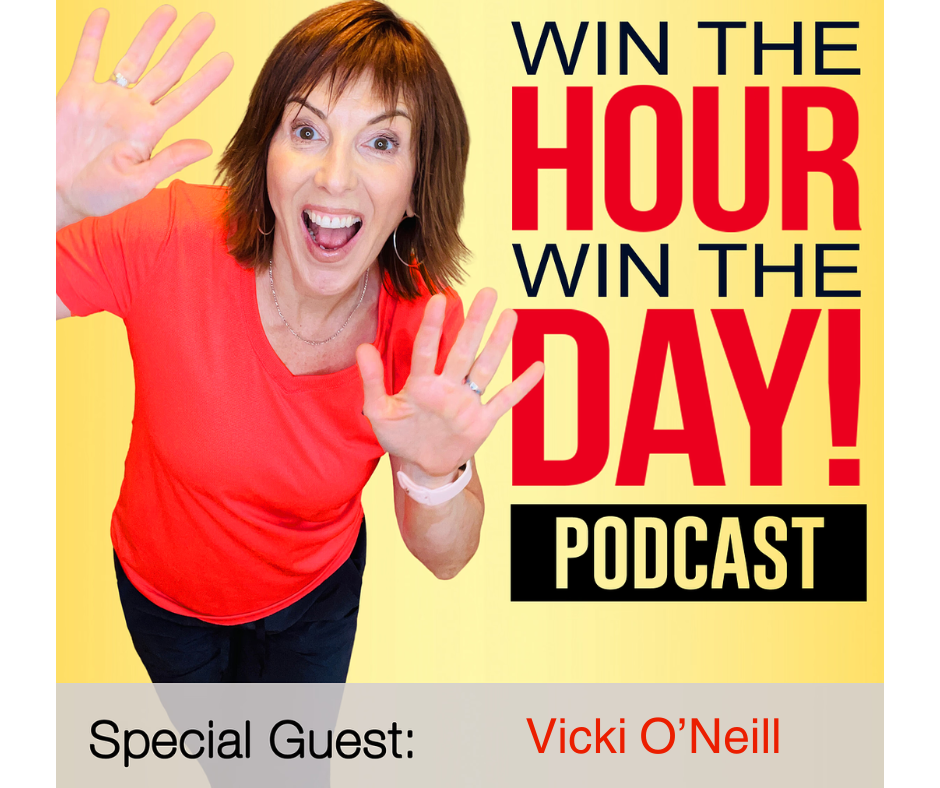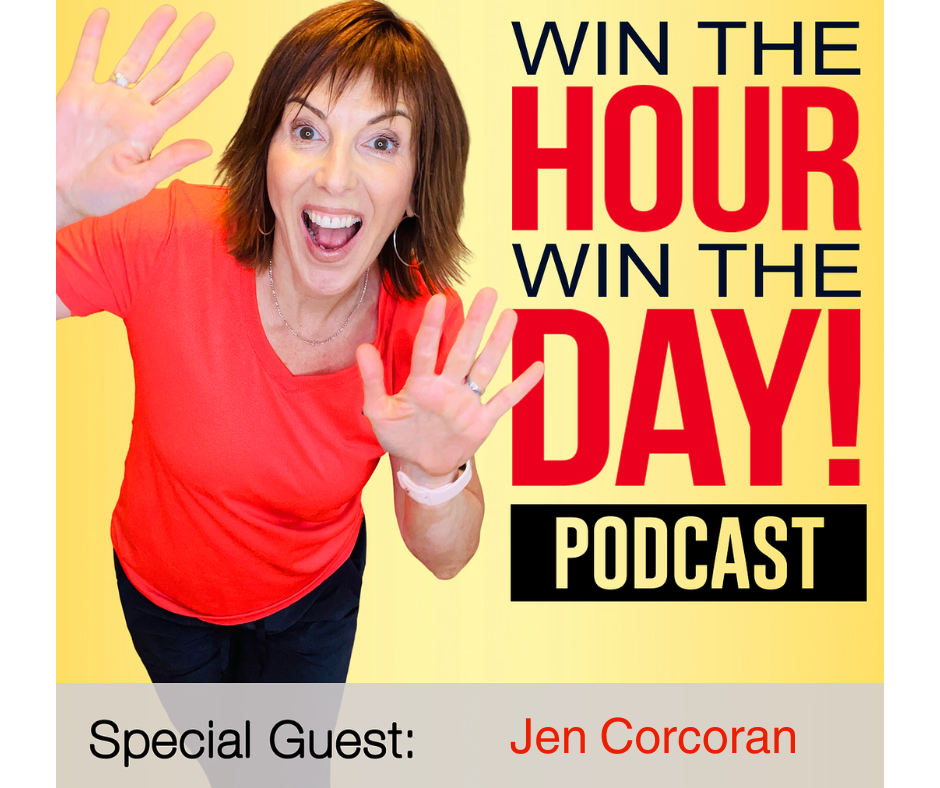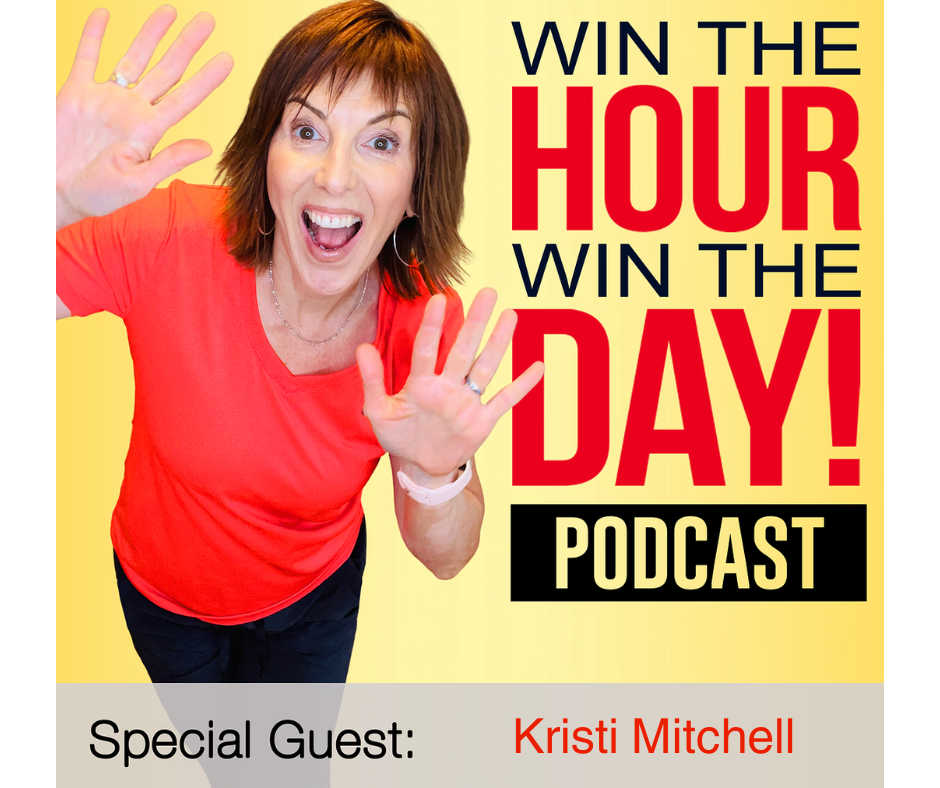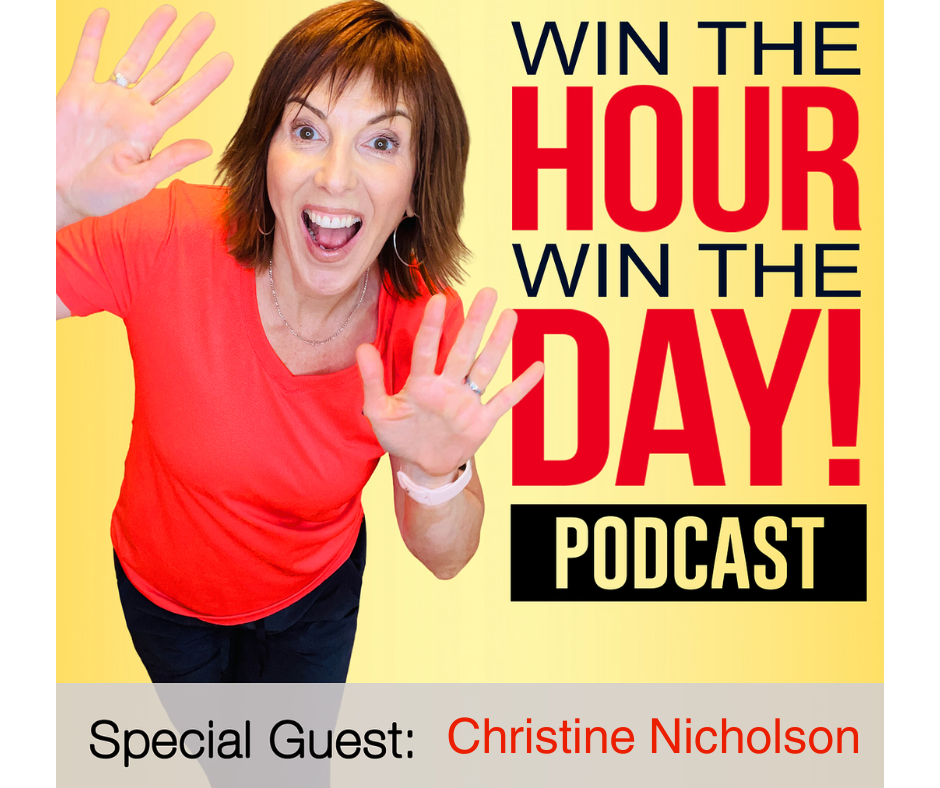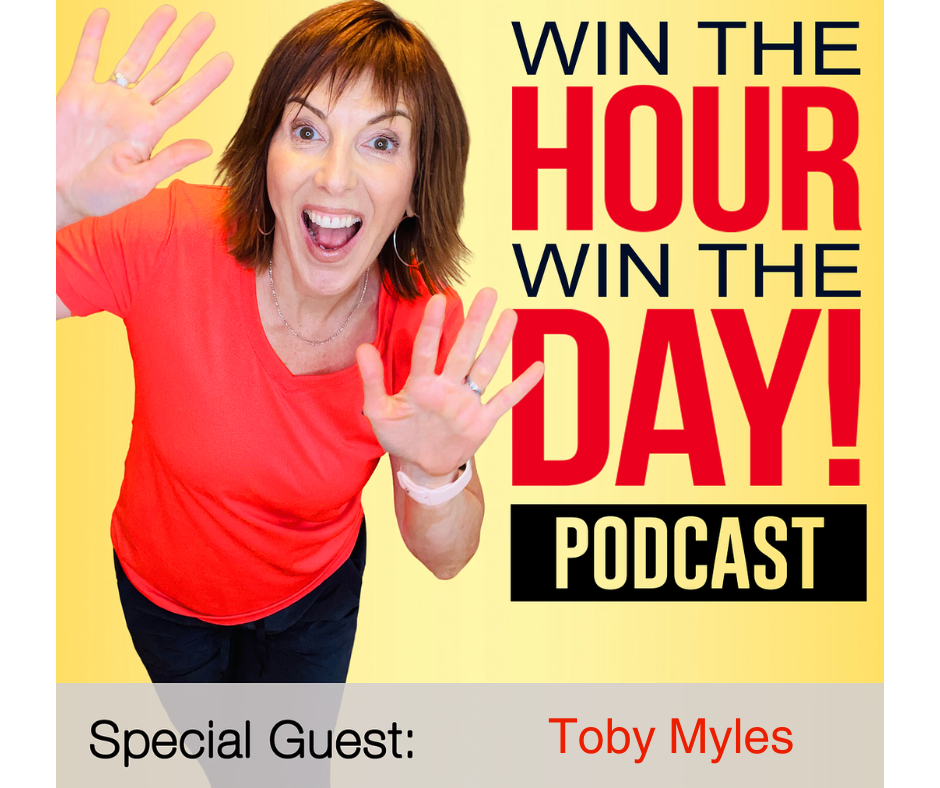Episode Summary
This week’s episode of Win The Hour, Win The Day Podcast interviews, Karen Grill.
Feel like email is just one more thing on your list? Think again! Karen Grill joins Kris to show you how email can actually save you time and make you more money.
In this smart and practical episode, you’ll learn:
-Why your email list is stronger than social media (and safer too).
-The big mistake most people make when sending emails.
-How to get your emails into inboxes—not spam folders.
-The easy way to know if people are actually reading your emails.
-What to send, how often, and how to make it simple.
-How to reuse your best content so you’re not starting from scratch.
This episode is full of quick wins and easy fixes. Don’t miss out on learning how to make email one of your best business tools.
Power Personality Quiz! http://winbacktimequiz.com/
Win The Hour, Win The Day! www.winthehourwintheday.com
Podcast: Win The Hour, Win The Day Podcast https://podcasts.apple.com/ca/podcast/win-the-hour-win-the-day/id1484859150
Facebook: https://www.facebook.com/winthehourwintheday/
LinkedIn: https://www.linkedin.com/company/win-the-hour-win-the-day-podcast
You can find Karen Grill at:
Website: https://karengrill.com/
LinkedIn: https://www.linkedin.com/in/karengrill1/
#SmallBusinessGrowth
#EmailMarketingTips
#KrisWard
Win The Hour Win The Day
https://winthehourwintheday.com
Karen Grill Podcast Interview
Kris Ward: [00:00:00] Hey everyone. Welcome to another episode of Win the Hour. Win the Day, and I am your host, Kris Ward. And today in the house we have Karen Grill and she is gonna talk to us about email strategy.
Now listen, in case you’re like me and you think, oh, sometimes email can be a yawn or just a battle you’re always fighting against. Karen is gonna talk to us. She went, within the first few minutes of talking to her, she mentioned a few things. I was like, wait, now I don’t know about that, should I know about that?
So let’s get to it. Welcome to the show, Karen.
Karen Grill: Hey, so much for having me, and I hope I can change your mindset a little bit around email. I know a lot of people see it as like this chore that they have to do, but what if I told you that you can earn more money with your email than you can with social media?
And what if your email is actually like an insurance policy for your social media if you get restricted or banned. So that’s why.
Kris Ward: Yeah, and that’s a really good point. And I think we need to be told that, at least I do on a weekly basis because to your point, I think we clump it all together. My consumption or keeping on top of the [00:01:00] emails that are sent to me are different than what I should be sending out.
But then I guess I paint it with the pain, same brush, and say hate all the emails I have to read. Why should I be doing that to people I wanna do business with? But I I know in my case, I have a two, actually a three TR system, but I have my main email where my clients, everybody reaches out to me and then I have a secondary email where things like social media or if I was on your email list, I go in there and I do go in there with a different attitude and a little bit more leisure.
Even the ones that I enjoy, you’re right, I am, I’m not putting my back into, or I do think my, I do send out an email broadcast every Friday, but I would say for the most part, we do it because we know we should do it. And it’s not a great amount of marketing and strategy put into it. It’s just okay, am I at least sending something out?
Really is the governing principle I’m operating under. Okay, so where should we start?
Karen Grill: So one of the first things I think people need to think about, not just the content, I think people always focus on what am I supposed to write to these people? But I [00:02:00] think now with some changes that Google and Yahoo made last year about authentication protocols, which means it’s harder to get our emails to actually even reach the inbox.
So in some ways it doesn’t even matter what you’re writing if it never even reaches people. So I think that’s the focus that we need to start thinking about first, is making sure we have some of the fundamentals in place so that at least our emails can reach people’s inboxes, and then we can talk about the content.
Kris Ward: Okay. So what does that look like? Are we just talking about the regular, when somebody comes on board, you have to authenticate them. It’s a well like what? What? Nevermind me guessing what’s happening there.
So they want to reduce spam for their end users. So for Gmail users and Yahoo users, they want less spam, which I think we can all agree is a great thing.
We all want less spam. They also wanna reduce spoofing and phishing, which are some, criminal activities.
Yeah.
Karen Grill: The way they can do that is by people having domain based emails. So again, your Kris Ward would be, Kris ward.com would be your domain based. Yeah.
You’re not sending through an email service [00:03:00] provider’s domain name.
So first you have to do that. But there’s something I call the alphabet suit. There’s all these acronyms that they have, SVFD, C-A-M-D-M-A, these are different protocols that we have to be able to do now, and basically what it’s doing is proving that you are actually the sender that you sent it. No, nobody has messed with it.
There’s security around what you’re sending and so we have to make sure we’ve implemented these three protocols in order to make sure we pass all the filters to get into the inbox.
Kris Ward: Dear Lord, this sounds like a lot of work. It sounded okay. So back up for a second. You’re so far, this isn’t getting more exciting, Karen.
Okay, hold on. Okay, so when you say. We have to make sure it comes from Kris ward.com or win the hour, win the day.com. That’s fine. We’re still able to use email provider services, whatever that is. Chimp Mail, constant contact, whatever. We can still use that. It’s the setup to make sure it comes from our platform.
So it’s authentic coming from us, correct? Oh, correct. And then do these platforms just [00:04:00] take care of it naturally with the whole Google and Yahoo authentication? What does that look like? Without getting too mechanical,
Karen Grill: right? No, and unfortunately they can’t do everything, but it’s the perfect place to start.
So let’s say use ConvertKit or Kit now. Active campaign, whoever you use, I would definitely go to them. They have typically some information about what you need to do on their end.
Kris Ward: Okay.
Karen Grill: They all created their own way of doing it. Unfortunately, it wasn’t like one way to do for every, ah, email service provider, so you really have to start there.
Just remember though it’s your domain reputation, so it’s more than just email. So it can be your website. Oh, make sure the whole thing is authenticated properly, but the first place to start, go to your email service. If you just Google in their help, email authentication or Google Yahoo 2024.
Okay? Something will come up for that.
Kris Ward: Okay? So let’s not get stuck there because what you’re saying, it’s a one time thing. Make sure we know at least we don’t know what we don’t know. So at least we are gonna go in and ask that question. Make sure that we’re good there. Okay, so we’ve taken care of this little headache.
Then what do we do next?
Karen Grill: I think one of the, misnomers [00:05:00] is they just keep sending email and they never check actually, like their email data, email metrics we have to be really careful because, if you do something wrong, you can get penalized and you won’t see that right away.
If people check like quarterly and you’re sending emails every week, something could happen before then and already ruined your center reputation. So I think some of the things we all need to do as business owners is to check our email data. At least once a month. I would suggest more if you send Okay.
And what that looks like is seeing, do you see a drop in your open rates? Do you see a drop in click-through rates? Really looking at, who’s opening, who’s not opening to ensure that, you can tell a little bit if your emails aren’t getting in the inbox. So you wanna be aware of that and be proactive right when it happens.
I think it’s also important we need to clean our list, right? So many people have bounced emails that they’re sending to, and the more you send to something like that’s a signal to Google and Yahoo to say wait, she’s sending email to people who don’t want it ’cause they’re not opening it. We need to penalize her.
So we need to be really on top of cleaning our lists.
Kris Ward: I think [00:06:00] sometimes I think we forget this because I. We know it. It’s so frustrating you to get some sort of spam phone call or somebody knocking at your door at dinnertime, whatever. They don’t seem to do that anymore to sell you things ’cause who does that?
But you still get some enthusiastic churchgoers or whatever. And we see that as such a violation and interruption to our time. And then I think we forget. That is the same power and annoyance when you get, when I get an email it’s not even through a EI don’t even know how they do it ’cause I guess they would do it manually.
But when somebody’s reaching out and saying, oh, I can help you with your website, and it’s just from them. And you can see it’s not an email, they’re not sending out to hundred people, but they’re, it is a cold solicit. I don’t know them. The signature’s not there. Who knows where they’re muck nowhere.
And I’m like, get me off your list. Like of course I’m not gonna send hire you. I don’t know. There’s no signature here. There’s no nothing. So I think as us as the email senders, we forget how annoying we can be ’cause we just assume I’m running a healthy business here. I’ve been in business for a while, so I [00:07:00] just assume you want me to knock on your door. And that’s not the case.
Karen Grill: So there’s definitely a big difference between cold emailing, which is what you’re describing, and permission-based email. So typically, most people will have some kind of opt-in where A PDF or a checklist or something.
Kris Ward: Yeah.
Karen Grill: People can give you their email for.
So they’re saying in return, for my email, I’m gonna get this PDF, so that’s permission based. And so really you’re giving us permission to send you emails, right? So I think that’s different than the cold emailing. And I think it’s important.
Kris Ward: Let me jump in there. I think you’re right. I was putting the two together, which again, I think with your industry.
I think we clump a lot of things together and then you are like, oh, we don’t like email, where you’re like, yeah, I’m talking about answer my email. It all gets clumped together. So I do think, okay, fine. It’s not a cold email. But I think we also, I forget that, I expect that when I send something about whatever happened this week that hopefully you’re just gonna all stop what you’re doing and read my damn email.
So I think you’re right. It’s really. It shows your aptitude for your work that you keep breaking it down ’cause I think we do clump email in with a lot of things.
Karen Grill: Yeah. [00:08:00] And I think it’s a little bit of a mindset shift that we have to have as business owners because in the past we could just send emails and if people didn’t open ’em, we just didn’t have a great open rate.
But now sending to people who don’t open it, we can start to get penalized. And our sender reputation.
Kris Ward: Ah.
Karen Grill: Get diminished. So we need to be think a little differently. How about, I think how we interact with our audience. We wanna make sure that they’re active. We want really people who want our information.
And I think people are so afraid to have people unsubscribe. Because they think, oh, I’ve worked so hard to get all these emails. I don’t wanna take one off. But really we wanna start to create a community, an audience that really is interested in what we’re talking about is engaged, right?
We don’t want people just to sit on our list to have a 10,000, subscriber email list when they’re not opening it or engaging at all. That doesn’t help us in any way. So I think we need to really think about maybe being small, but really being active in terms of our audience. And we can better understand our audience and make sure we’re sending them the information that is really relevant to them and really resonates with them.[00:09:00]
Kris Ward: Yeah, that makes sense. Okay, so what are some tips for doing that?
Karen Grill: I think we have to start, doing maybe some polls if you have an existing list and you haven’t really touched base with them a while. I think we need to figure out what do they wanna hear from us. And I think it’s so important to start segmenting our audience.
So let’s say, you’re an accountant or somebody I. You might have some people that are sole proprietors. You might have some people who have an LLC. You might have some people who have an S-corp have different business structures. Sending ’em all the same information probably isn’t gonna work, right?
Because cer certain LLC things don’t apply to S-corps or sole proprietors. So we need to start thinking about our audience a little differently. Do we have shades of our avatar? And you really need to think about that and if there’s different ways that you can segment them. So if you have different lead magnets, that’s the first place to start, right?
You make sure, okay. Tags on each of them, making sure that you can say, oh, they really like this one. Maybe they, I can offer them this one instead of just sending blanket emails to everyone. We wanna start being more relevant and more targeted in what we’re [00:10:00] sending.
Kris Ward: I think the most profound things are simplistic and common sense almost, because when you say that, you’re like of course that makes sense.
I’m not gonna walk into a room and there’s 10 people there and try to be generically speaking to all 10 of them at the same time. I wouldn’t have a sales call with 10 people at the same time of different businesses. Let’s just get on this call and see if I can tell to all of you at the same time.
That makes so much sense. But I think what we would do, I know I probably say, okay, here’s the email, and in this email I would try to tap into maybe three different sections of, oh, if you’re sole proprietor, if you’re here, you’re there. And tie those all three into one email or to one story. So that’s a very salient point, is stop trying to talk to everyone.
Talk to everyone you talk to. No one.
Karen Grill: And you can send some of those, but I think, we get better results when it’s more targeted and more relevant. Yeah. Individual. So we’ll have higher open rates and most likely than higher engagement and maybe taking the conversion step right, that we want.
So I think you can send blanket emails to everybody, but I think that’s what we’ve always done. Now we need to [00:11:00] start thinking a little differently and thinking, okay, what segment could I send to today? Like maybe people all, a certain portion, open this specific email on a specific topic.
You could maybe tag those people and say, oh, they really if I’m talking about email authentication, right? Then I could send specifically information to them about that. And the other people who didn’t open that wasn’t interesting for them. So we need to start really digging into our email list and figuring out what segments of our audience want, what information
Kris Ward: and are you a proponent of when they come onto the list?
No matter which way, like what opt-in or whatever would I give my backstory or what I do or why I do we have an intro email that goes at the same or similar to all different lists?
Karen Grill: You can definitely have some kind of introductory email. I think though what seems to work best, especially if you have some kind of league magnet, let’s say it’s a checklist or like a brand identity thing you want them to go through, is to really help them to complete that.
How many times have we downloaded something and we’ve never completed it, right? We really wanna get people to complete it. So if we can help them take little wins. So let’s say you have [00:12:00] one action you want them to complete. Maybe that first email is Hey, did you try this? Here are three mistakes people make, or this are where people get, oh.
Helping them to complete it. Yeah. They get wins and they have that connection with us, that, oh my gosh, she helped me, complete my brand identity or whatever that was. Yeah. So we’re really helping them. I think they care more about that. And then towards the end of maybe that sequence, you could talk more about yourself, but really they care about themselves.
They wanna get results. And so if we can help them right from the beginning do that, I think that’s more effective.
Kris Ward: I like that. And that’s the thing is everybody. I’ve ever spoken to before. They’re always like, we have to have this onboarding email sequence, and there’s three or five emails and you tell your journey and I’m thinking, who cares?
I, even if I liked your product or your service, maybe at best you’re gonna get me to read one email, but you and your dog and your wonderful childhood. But even then, it’s that’s not, it’s great to humanize people, but at the same time. That’s if I’m learning about LinkedIn and I see somebody online, I’m like, oh, they got really great LinkedIn tips.
I’m over here talking about LinkedIn, and then you switch me to email and now I’m hearing [00:13:00] about your dog and your childhood. Those are two different conver, like I didn’t come in for that reason. So that’s what they kept shoving down my throat and I was like going, I, why would people K? Why do I need to, why do they need to hear my life story?
I don’t know. Okay. That makes more sense to me. All right.
Karen Grill: I. We do wanna create connection with them, but I don’t think that’s what you wanna send right off the bat. Like we wanna help them see that, we have a solution to their problem, that we can help them get there, taking these steps and then we can tell a little bit of us when they’re convinced that you’re right, she does help us.
We wanna stay with her. Yeah.
Kris Ward: Then you, she, oh, she’s smart. She’s got some product. She can get me time back. I have hired five VAs and didn’t know what I was doing. Oh. And then when I trust her, oh, get to know, oh, I also like to bike ride and whatever. Then you make it relatable. But to me it’s like a little bit of a switch and bait.
I, and I also, for me, I. For me, it felt a little arrogant, like I’m not an influencer, and people don’t understand that journey is if you become really whatever, if you become really [00:14:00] good at your business, let’s say let’s just make somebody up, Sarah Jones, and she’s really good at her business and she talks about LinkedIn and she’s amazing and she’s got this huge following, then people start to wanna know the backstory.
Okay here, yeah, she takes care of her health so she can lean into her business and here’s some things she eats, and all of a sudden we’re into the life story. Style side of that because we value how she built her business and her life. And so people, I feel get confused going, oh, they wanna hear all this backstory about you.
No, I haven’t earned the right, I, they haven’t consumed all about me and been impressed by everything I do and now wanna see how I do it constantly. How I do one thing is how I do everything. It’s no, I’m still earning my position at the table. It’s not time to tell my heroic story. So I think it’s it’s just information that’s irrelevant.
Karen Grill: Yep. And we never know how people come to us. Maybe they’ve been following me for years on LinkedIn know everything about me already.
Kris Ward: Yeah.
Karen Grill: But they’re more likely the probability that people don’t know about you and they don’t need to at first. It again, yeah. Really helping and supporting them and then them trusting you [00:15:00] and then they’ll wanna know about you.
Kris Ward: Yeah. First let’s find out if I’m helpful. Then we’ll find out if I’m likable, right? Doesn’t matter if I’m likable and I’m not helpful. Okay, so making lots of mistakes here in email. What are some other common mistakes that you see that we just don’t talk about enough?
Karen Grill: So I do think that people really worry about what they’re gonna be sending, right?
And so many of the people I work with are already creating content for social media. So I don’t want you to continually reinvent the wheel, right? You probably already created content that you could repurpose into emails, right? A lot of times on social media, maybe it’s kind of surface level, right?
And maybe with email, then you go a little deeper into one section of that, right? So if you have developed your pillars for your content strategy for social media, it can be used again for email. And I think people complicate it, yeah,
they get so stressed about what to send to your email list where really you have some ideas and I would look at the content that did really well on social media and say, oh, people really liked when I talked about this.
Then maybe do [00:16:00] a deep dive into that for them and say, Hey, if you wanna learn all behind the scenes of how I do this then you can go on and go deep into the email. I don’t want people to stress. I don’t want people to think that they have to spend hours and hours creating that email.
Start with what you have, start testing that and seeing what people are opening, and then you’ll have a better direction of what you need to be posting on your email.
Kris Ward: Yeah, I agree. There’s lots and lots to repurpose for sure. I, that’s okay. So don’t make it a big deal. You can definitely repurpose.
And something I was saying to a business friend of mine too, like he is a rock climbing gym, and I was also saying like a lot of your stuff can be in, especially in his case, can be seasonally repurposed. Oh, okay, here’s the march break, or Here’s why you wanna do this at Christmas and whatever. So you can also have a healthy framework depending on the nature of your work.
For me it might be something like. I don’t care how old you are. I think back to school and back to work, there’s a different, like something is lit under us and a little different energy in September. Okay, game on. Like we’re heading into winter. There’s lots of hours to work. I don’t, [00:17:00] it’s just a different vibe and so I could be talking about.
Don’t start, let’s not get back to school and back to work and you’re working these crazy hours again. Let us help you with blah blah blah. Or I talk about the Christmas crawl. People start to think somewhere about the first week of December, I just gotta get to Christmas.
I’ll deal with this in New Year deal, this is a new year, and they come back, it’s a hot bloody mess in the new year, right? So those things can very much be seasonal. There is probably somewhere between six and 12 pieces of content that easily. Is, if not the exact same thing, 90% of the same thing that you would really talk about from last year.
Karen Grill: Yep. And I think we all need to start creating this digital asset library, right? Where we keep all of our content, where we keep all of our images, all of our videos. So it’s really easy then to repurpose, like you’re not always hunting for everything, right? We wanna give it one place and make it really easy for us to save us time.
Kris Ward: A hundred percent. We have a very simple spreadsheet and in that spreadsheet, so we’ll have the title of it because, and, but what I also do is say, okay, here’s the theme of it, [00:18:00] because that’s, you wanna be careful that no matter what you’re talking about, it’s gonna be mostly similar. So let’s say I talk about whatever the three biggest mistakes people make with hiring a VA.
So that might be the loose content. And then in the next column we have, but I list them because the three biggest mistakes might, I might, I might highlight one or I might talk about three different ones the next week. Your content is similar, so you have to break it down. So a simple spreadsheet of what you’re talking about, what that really means when aired it or, and even sometimes we’ll put a description like.
Kris is standing by a car talking. So we’re like, oh yeah, I know that video. Whatever. It doesn’t have to be fancy. We’ve tried all different social media platforms and it gets very complicated and I find each and every one of them has one thing where they go, yeah, you can pay this amount every month, but on, on LinkedIn you can’t shoot a video or on this one you can’t add music or whatever.
So I just find the spreadsheet really simple. But you’re right, you can repurpose a lot.
Karen Grill: Yep. And keeping it all in one place so you know where to go. Yeah.
Kris Ward: And I like your [00:19:00] language too. Digital assets. I think that’s how we really have to take a look at it. Your assets or your inventory, it, that’s a pretty powerful word, and I think we don’t respect it enough.
Karen Grill: And I think I see email as a business asset too, right? So we need to make sure that we’re like that. We’re not just thinking it’s like a throwaway thing that we have to do. You really need to see it as part of a business asset.
Kris Ward: So what do you, when you’re thinking about open rates and hooks, do you have any suggestions there? cause it’s all well and good, but we have to get them to open it,
Karen Grill: right? So open rates are a little tricky since apple iOS, they change, they mark everything as open. Oh. And so aren’t as effective as they used to be. However, I don’t want you to dismiss them. Like I think they still work, but you have to look at them long term, like over time is your open okay.
Changing or not. Really, we really need to look at click-through rates. That is really something. And so as business owners, we need to be making sure that we’re actually putting things in there for them to click, right? If we don’t put anything to click, we’re not actually seeing, are they engaged with our emails.[00:20:00]
Another thing we can do is also say hit reply. Like we want them to reply to us. We wanna start having conversations, developing relationships with our subscribers so that we can better understand what they want from us. Those are two things we wanna be making sure that we’re monitoring.
Like I said, if that’s every a month once we get that baseline for the open rate, then we change, tend to look for the click-through rate, and then the reply rate.
Kris Ward: That’s a really good point. ’cause for a while there was a discouragement about putting links in your emails. ’cause it’s oh yeah, that’s a link and that slows it down or this whatever.
The fairy gods of the internet don’t like that. So I see your point now it’s okay, if everything’s out open rate, we really need to see who took action so that we know they did see it, read it. Not just even if they did open it and they didn’t read it, it’s on their screen. Like that still does us no good. So now we’re back to make sure you have a link in there.
Karen Grill: Yeah, and email service providers help you with this. They’re not even links to go somewhere. It can be, so do you wanna hear more about, email authentication or open rates? And they click that and then they tag them so we know, oh, they want about open rates.
So [00:21:00] then I know that I can send content to them about open rates. So it’s not even links to like your website or something, it’s just like email links so that we know better, like what they’re interested in, what they’re not.
Kris Ward: Some sort of action that they’re raising their hand.
Karen Grill: Exactly. Yep. Okay.
Kris Ward: My gosh.
All right. Okay. And what’s your recommendation? Once, I know it’s gonna depend, but do we send an email once a week regularly? What are we looking at?
Karen Grill: So the way I usually describe it is I think it’s a combination of what we can do as business owners and what we think our audience would like.
A lot of people start sending emails like every week or something and then they stop. So I think it’s much better to think, okay, what can I do for 52 weeks? So if that’s once a month, okay, start there. If you can do once a week. Even better. But you need to make sure that you’re setting expectations with your audience.
You wanna say, okay, I’m gonna email you every week on these topics. And if you set that expectation, they’re gonna expect that. So if you send it for four weeks and then you stop, that’s a weird relationship that you start. Yeah.
Kris Ward: Yeah.
Karen Grill: So that then if you send an email, they’re like, who is this?
And [00:22:00] they’re more likely to mer you a spam, which is what we don’t want, right? So we wanna make sure that we’re setting the expectations for them, but also then making that commitment for ourselves. I work with people who send an email every day and make hundreds of thousands of dollars, and I work with people who send it like once a month and make hundreds of thousands of dollars.
So it’s really that relationship that you build with your audience.
Kris Ward: Okay, said. Alright Karen, where can we find more of your brilliance?
Karen Grill: So you can go to karen grill.com and then I hang out a lot on LinkedIn so you can find me there.
Kris Ward: Oh my gosh. Okay. Share this show with a buddy. Lots of oh my gosh.
Send it to a business friend or whatever, because there’s a lot of subtlety here, but very powerful. And I think it’s so easy in this day and age of a and i, AI, a and I dunno what that is, AI, to be chasing that and then forget the basic principles. And there, there was just a lot of clarification today that I found really helpful.
So thank you very much, Karen.
Karen Grill: Oh, thanks so much for having me. I think email is still powerful and [00:23:00] we just need to try to Yeah. As business owners.
Kris Ward: We need to remember that. All right, everyone else, we’ll see you in the next episode. Thank you so much.


